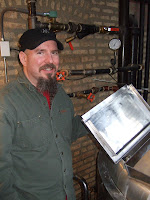 Over the weekend we rented bikes to go through the English Garden and stopped at the second largest biergarten in Bavaria for lunch while the sun was still out. We admired the fellows that surf the river in the park.
Over the weekend we rented bikes to go through the English Garden and stopped at the second largest biergarten in Bavaria for lunch while the sun was still out. We admired the fellows that surf the river in the park.On Sunday we went to the Deutches Museum to ponder for hours their wonderful technology displays.
But enough about touristy stuff; let's talk about beer style. The German brewmasters recognize many different variations in beer styles.
Pale lager exists in two catagories: Munich Helles and non-Bavarian Helles. Munich Helles is very slightly sweeter, fermented traditionally in open fermenters and has HUGE amounts of SO2 due to the pressurization of the fermenting tanks to achieve natural carbonation. It's also a bit darker (9-12 EBC) due to single decoction mash. Non-Bavarian Helles has a higher degree of attenuation (82-86% apparent). This is the style we know in the States as European light lager.
The Pilsner category can be divided up to three styles: Bavarian, North German and Bohemian. Bavarian is less hopped, degrees dropping as low as 20BU and taste more like Helles lager. North German is mid-range to high and Bohemian is always high sometimes pushing 45BU. Original pilsners were much darker and sweeter than the pilsners we know today and always had a hint of diacetyl. This color change was caused by the intensive decoction procedure. It was felt that the pale malt made in the Bohemian area would not make good beer so intensive boiling was instigated.
More beer styles later...






























